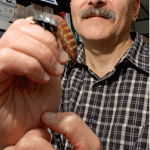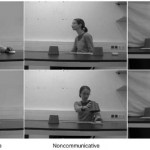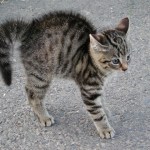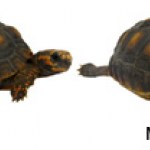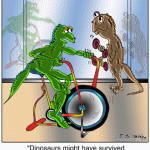communication
Research published in the Journal of Experimental Biology shows that noisy humans are impacting the physiology and behaviors of dolphins and whales. To compete against man-made noises, these animals are altering the amplitude, frequency or length of their vocalizations or repeat what they need to say with the hope of being heard. Dr. Maria Holt and colleagues studied a par of bottlenose dophins vocalizing and discovered that the oxygen intake of the animals increased as they raised their voices. The team then calculated the number of additional calories the dolphins…
Entomologist Dr. Coby Schal at North Carolina State University studies the chemicals involved in insect communication in an effort to more effectively manage pests. His big interest is in chemical communication using pheromones and how they impact mating and other behaviors. His research has aided the control of cockroaches, bed bugs, mosquitoes and other nuisance bugs in major cities.
A very nice biography of his work was recently published in The Scientist. Some major discoveries that Dr. Schal made as a graduate student included observing that male cockroaches sit higher up in foliage in…
I have a post up today at the Scientific American Guest blog, discussing how an earthquake and denial led to prairie dog plague. It details an outbreak of plague in Victorian San Francisco--the first time plague hit the United States--and the many downstream consequences of that outbreak (which began in 1900 and wasn't really contained until 1908). While the story is over at SciAm, here I wanted to talk more about why the outbreak became such a public health disaster.
The outbreak was first recognized by Dr. Joseph Kinyoun, a bacteriologist who had been, until his transfer to San Francisco,…
I am having a conversation with my friend, Pat. We are talking about the way we talk when we have a chance to spend some time, or the way our emails seem to go.
“I tire of being asked what I think about something only to have the conversation derailed at the first ‘bump’ in my logic, at the first self-contradiction,” Pat says, of life in general.
My response: “I savor your contradictions. It's my desire to explore them with you and to experience the change that happens when you wrestle with them.”
“Yes, I think you get it. How refreshing.”
As you can see, Pat and I have a deeply meaningful…
This is a response to Critiquing the “Critique” and the “Critique of the Critique” of Bill Nye’s Video at UrbanAstro.org. In that post, FURYGuitar addresses both Critiquing the Critique of Bill Nye’s Video by me and Bill Nye’s “Don’t Teach Creationism…” Video Dissected by Business Communication Expert in which scientist and marketing expert Marc Kuchner writes in a guest blog for Scientific American Blogs an interview with communication expert Patrick Donadio.
The background is that Bill Nye made a video called Creationism is Not Appropriate for Children that some viewed as controversial…
This image has been going around the intertubes recently, I saw it first on Planet 3.0 and again on APOD. It is one of those interesting illustrations of large quantities that seems surprising or anti-intuitive either because you never thought about it carefully before or just because it is hard to get your head around sizes that are so far outside the realm of everyday experience.
Anyway, I am posting it because my wife insisted (a very unusual turn of events, considering the usual frown upon spending my non-work time on the computer!). When she saw it she became quite alarmed and thought…
by Kim Krisberg
Broccoli. A nutritious green veggie of the cabbage family? Or a symbol of the federal government's over-reaching power grab? Like most things in life, it all depends on your perspective.
I've been thinking about that word -- broccoli -- since last month's Supreme Court hearings on the constitutionality of provisions within the Affordable Care Act (ACA). Specifically, I've been pondering this comment from Justice Antonin Scalia during arguments on the ACA's individual insurance mandate:
SCALIA: . . . could you define the market -- everybody has to buy food sooner or later, so…
I think I saw this on Planet 3.0, but wherever, the video below, documenting the late Stephen Sneider's remarkable efforts to communicate the urgency and nuance of our climate crises to the public, is very well done. Please watch.
On Tomorrow's Table, Pamela Ronald shares a breakthrough in the study of bacterial communication. Although bacteria have been known to use a limited chemical vocabulary, for the first time they have been observed to use a protein as a signalling mechanism. Ronald writes, "Ax21 is a small protein. It is made inside the bacterial cell, processed to generate a shorter signal and then secreted outside the bacterium." In the species studied, perception of Ax21 caused nearly 500 genes—ten percent of the bacterium's genome—to change expression. Thus galvanized, individual bacteria assemble into…
By Kim Krisberg
We're talking about it all wrong. Health reform, that is. We (reformers) think we're answering the questions that will change opponents' minds, when there's no answer that will ever satisfy. My head hurts just thinking about it (though a giant, energy-efficient light bulb flickered on over my head after I thought about it a bit.)
In essence, how do we talk about public health values? That was one of the main -- and I think most interesting -- topics at the American Public Health Association's Midyear Meeting in Chicago in late June, which focused exclusively on "Implementing…
Human infants have one important job during the first years of life, and that is to learn about the world and their culture from their parents and other caregivers. But what is learning? I've previously written that Hungarian developmental psychologists Gergely and Csibra have defined learning as the acquisition of new, generalizable knowledge that can later be used within a new context. Further, they have posited that evolution has prepared humans to learn generalizable knowledge from their caregivers. They proposed an elegant hypothesis: that a specialized innate pedagogy mechanism - called…
What is learning?
Most psychologists (indeed, most people in general) would agree that learning is the acquisition of new knowledge, or new behaviors, or new skills. Hungarian psychologists Gergely and Csibra offer a deceptively simple description: "Learning involves acquiring new information and using it later when necessary." What this means is that learning requires the generalization of information to new situations - new people, objects, locations, or events. The problem is that any particular piece of information that a human or animal receives is situated within a particular context…
There's a very well-known experiment in developmental psychology called the "A-not-B task." The experiment goes something like this: you, the experimenter, are seated opposite a human infant. Within the reach of both you and the child are two boxes: box "A," and box "B." You hide a toy in "A," in full view of the infant. As expected, the infant reaches for "A" to retrieve the toy. You repeat the process several times. Each time you hide the toy in "A," and each time the infant reaches for "A" to find the toy. Experimental set-ups like this are extremely common in infant and animal studies.…
Given the recent elephant hunting scandal, I thought I'd repost this award-winning piece from the archives, on a very clever way to deter elephants from raiding human settlements. Much cleverer than shooting them. (Click on the archives icon for the original.)
What information is contained in the call of a mammal? Some calls might reflect the internal emotional state of the animal, like fear or anxiety, or they can refer to an external object, agent, or event, like the presence of a predator. Rhesus monkeys, lemurs, baboons, and guinea pigs, for example, will produce calls when separated from…
Lots of animals are well aware that bigger means scarier. In stressful or aggressive situations, for example, the hair or fur of chimpanzees, rats, cats, and even humans stands up on end (in humans, given our lack of fur, this results in goose bumps) in an effort to dissuade a potential attack. Elephant seals use a display called "rearing up" to make themselves look bigger - as if they need to look bigger in the first place!
Since some animals tend to be good at looking bigger than they truly are, visual cues may not actually be a reliable method of sizing up another individual. In addition…
In one of a series of stories on animal intelligence, Anderson Cooper went to see Kanzi, probably the most famous bonobo in the world, and primatologist Sue Savage-Rumbaugh, who has worked with Kanzi almost his entire life. Using his board of symbolic "lexigrams," Kanzi apparently indicated that Cooper should don a bunny suit. One wonders whether the producers asked Savage-Rumbaugh to selectively interpret Kanzi's intentions in that way, and how much footage wound up on the cutting room floor. In any case, its actually pretty funny.
Okay, "A Team" was a little to simple, and it was taken. Instead I would like to inform readers of the "CSRR" Team, or CSRRT. I will let the press release speak for itself:
NAME: Climate Science Rapid Response Team (CSRRT)
WEBSITE: www.climaterapidresponse.org
WHO & WHAT: The CSSRT is a match-making service between top scientists and members of the media and office holders and their staffs from various levels of government. Our group consists of dozens of leading scientists who wish to improve communication about climate change. The…
Have you ever been at a party with lots of people chatting away, when for some unexplainable reason you felt compelled to turn and look at the front door of your friend's house...and just as you were looking, someone was just coming in from outside and closing the door? You couldn't have heard the door open since there was so much noise already inside - more likely you noticed that other people were looking at the front door. All of this probably happened without any explicit intention or awareness. If several others are all directing their attention at a specific point in space, there might…
Have you ever been walking through the forest and thought to yourself, "Damn, its loud here...it's really, really hard to hear anything anybody else is saying"? Well, maybe that's what prompted Terry J. Ord and Judy A. Stamps, respectively from Harvard and UC Davis to investigate lizard exercise routines.
You ask: What do lizard calisthenics and communication have in common? Patience, grasshopper.
Dinosaurs also might have survived if they weren't eaten by giant snakes.
A noisy environment makes it particularly challenging for animals to detect communication signals from far away. In this…
In 1975, Edward Tronick and colleagues first presented the "still face experiment" to colleagues at the biennial meeting of the Society for Research in Child Development. He described a phenomenon in which an infant, after three minutes of "interaction" with a non-responsive expressionless mother, "rapidly sobers and grows wary. He makes repeated attempts to get the interaction into its usual reciprocal pattern. When these attempts fail, the infant withdraws [and] orients his face and body away from his mother with a withdrawn, hopeless facial expression." It remains one of the most…
